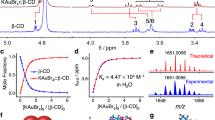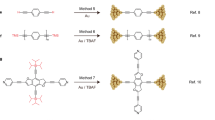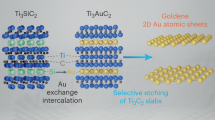Abstract
IN its complex compounds, tervalent gold appears to be invariably four-covalent, the four bonds being co-planar and pointing to the corners of a square, as in K[AuBr4],2H2O1. This suggests the use of 5d6s6p2 bonds, which is in accordance with the observed diamagnetism of tervalent gold compounds2. The stereochemistry of univalent gold, however, is less well defined. As a rule, the co-ordination number is two, and examples of this include the anion3 [AuCl2]− and the phosphine complexes of the type [R3P,AuX]., where X = halogen4. In those cases which have been investigated by X-rays, the two bonds to the gold atom are co-linear5.
This is a preview of subscription content, access via your institution
Access options
Subscribe to this journal
Receive 51 print issues and online access
$199.00 per year
only $3.90 per issue
Buy this article
- Purchase on SpringerLink
- Instant access to full article PDF
Prices may be subject to local taxes which are calculated during checkout
Similar content being viewed by others
References
Cox and Webster, J. Chem. Soc., 1635 (1936). See also Sidgwick, “The Chemical Elements and Their Compounds”, 183 et seq. (Oxford, 1950).
Selwood, “Magnetochemistry”, 103, 182 (Interscience, 1943).
Wells, H. L., Amer. J. Sci., 3, 315, 417 (1922).
Mann and Purdie, J. Chem. Soc., 1235 (1940).
Sidgwick, “The Chemical Elements and Their Compounds”, 137 et seq. (Oxford, 1950).
Meyer, C.R. Acad. Sci., Paris, 143, 280 (1906).
Levi-Malvano, Atti R. Acad. Lincei, 17, 857 (1908).
McCluskey and Eichelberger, J. Amer. Chem. Soc., 48, 136 (1926).
Dothie, Llewellyn, Wardlaw and Welch, J. Chem. Soc., 426 (1939).
Kabesh and Nyholm, J. Chem. Soc., 38 (1951).
Foss and Gibson, J. Chem. Soc., 3063 (1950).
Nyholm, J. Chem. Soc., 2061 (1950).
Author information
Authors and Affiliations
Rights and permissions
About this article
Cite this article
NYHOLM, R. Stereochemistry of Gold. Nature 168, 705 (1951). https://doi.org/10.1038/168705a0
Issue date:
DOI: https://doi.org/10.1038/168705a0



